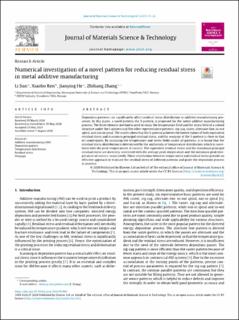| dc.contributor.author | Sun, Li | |
| dc.contributor.author | Ren, Xiaobo | |
| dc.contributor.author | He, Jianying | |
| dc.contributor.author | Zhang, Zhiliang | |
| dc.date.accessioned | 2020-10-28T14:55:28Z | |
| dc.date.available | 2020-10-28T14:55:28Z | |
| dc.date.created | 2020-05-25T09:39:31Z | |
| dc.date.issued | 2020 | |
| dc.identifier.issn | 1005-0302 | |
| dc.identifier.uri | https://hdl.handle.net/11250/2685548 | |
| dc.description.abstract | Deposition patterns can significantly affect residual stress distribution in additive manufacturing processes. In this paper, a novel deposition pattern, the S-pattern, is proposed for the additive manufacturing process. The finite element method is used to study the temperature and stress field of a cuboid structure under the S-pattern and five other representative deposition patterns: zig-zag, raster, alternate-line, inside-out spiral, and outside-in spiral. The results show that the S-pattern achieves the lowest values of both equivalent residual stress and maximum principal residual stress. The maximum values of them are 9.5% - 32.7% and 10.8% - 36.9% lower than that of other patterns respectively, while the warpage of S-pattern is close to that of most patterns. By analyzing the temperature and stress field under all patterns, it is found that the residual stress distribution is determined by the uniformity of temperature distribution, which is correlated with the peak temperatures of corners. The equivalent residual stress and the maximum principal residual stress are inversely correlated with the average peak temperature and the minimum peak temperature of corners, respectively. These correlations between temperature and residual stress provide a new approach to compare the residual stress of different patterns, which can be easily used in practice. | en_US |
| dc.language.iso | eng | en_US |
| dc.publisher | Elsevier | en_US |
| dc.rights | Navngivelse 4.0 Internasjonal | * |
| dc.rights.uri | http://creativecommons.org/licenses/by/4.0/deed.no | * |
| dc.title | Numerical investigation of a novel pattern for reducing residual stress in additive manufacturing | en_US |
| dc.type | Journal article | en_US |
| dc.type | Peer reviewed | en_US |
| dc.description.version | publishedVersion | en_US |
| dc.source.journal | Journal of Materials Science & Technology | en_US |
| dc.identifier.doi | 10.1016/j.jmst.2020.05.080 | |
| dc.identifier.cristin | 1812385 | |
| dc.relation.project | Norges forskningsråd: 281927 | en_US |
| dc.relation.project | Norges forskningsråd: 269558 | en_US |
| dc.description.localcode | © 2020 Published by Elsevier Ltd on behalf of The editorial office of Journal of Materials Science &Technology. This is an open access article under the CC BY licen se (http://creativecommons.org/licenses/by/4.0/). | en_US |
| cristin.ispublished | false | |
| cristin.fulltext | postprint | |
| cristin.qualitycode | 1 | |

